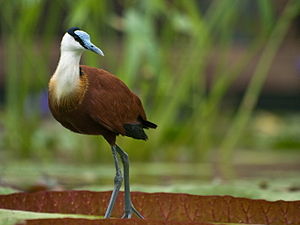Blue-fronted Jacana
| Blue-fronted Jacana | ||||||||
|---|---|---|---|---|---|---|---|---|

Blue-fronted jacana ( Actophilornis africanus ) |
||||||||
| Systematics | ||||||||
|
||||||||
| Scientific name | ||||||||
| Actophilornis africanus | ||||||||
| ( Gmelin , 1784) |
The blue-fronted jacana ( Actophilornis africanus ) is an African bird of the order of the plover-like (Charadriiformes). It is a resident bird , but when the water level is unfavorable it also nomadizes over a large area.
description
Blue-fronted jacanas show a striking difference between the two sexes. The females reach a body length of up to 30 centimeters and are therefore significantly larger than the males. On average, they weigh 70 percent more.
The most noticeable features of the blue-fronted jacana are its gray toes and claws, which are very long in relation to its size. They allow blue-fronted jacarons to walk over floating plants because they allow them to distribute their weight more evenly. Because of their lower weight, the lighter males can penetrate further than the females in the floating plant belt. The top of the bird is maroon in color with black wing tips, eye stripes and a back neck. The underside is white with a brown belly spot. The blue beak is elongated into a forehead shield.
Occurrence and habitat
The African Jacana lives in shallow waters with surface growth in Africa south of the Sahara . It is absent in the more arid regions in the east and southwest of southern Africa. On the other hand, it is very common in regions with more precipitation. It is only missing in the region of the tropical rainforest.
Blue-fronted jacaras inhabit both permanent and temporary wetlands. It uses both flooded plains and artificially dammed bodies of water. In western Africa and central Africa it also populates rice fields. Its preferred habitat has a large number of floating plants.
behavior
The bird runs with its long toes over floating plants looking for insects .
Reproduction
Blue-fronted jacaras have a polyandric reproductive system in which dominant females mate with multiple males. The breeding and rearing of the young is then the sole responsibility of the males, while the females continue to watch over the territorial boundaries.
Broods occur in all seasons. Four brown eggs with black spots are laid in a floating nest and incubated by the male. The male usually takes on the brood with the third egg. The chicks are waddled between the wings and the body and, if necessary, carried away running or flying in this way. Even if they pick their own food, the chicks are dependent on the male showing them how to eat and that they can eat in company with adult birds. The development of the chicks is very slow compared to other wader species . They are led by the male parent bird for up to three months.
Hazardous situation
The blue-fronted jacana is included in the Red List of Threatened Species by the International Union for Conservation of Nature IUCN . The species is endangered locally by the reduction and loss of wet areas; However, due to the extremely wide distribution, the stable population trend and the large population numbers, the species is overall assessed as not endangered ( least concern ).
literature
- Phil Hockey: Waders of Southern Africa . Struike Publishing Group, Cape Town 1995, ISBN 0947430458
Web links
- Videos, photos and sound recordings of Actophilornis africanus in the Internet Bird Collection
Individual evidence
- ↑ W. Grummt, H. Strehlow (Ed.): Zoo animal keeping birds . Verlag Harri Deutsch, Frankfurt am Main 2009, ISBN 978-3-8171-1636-2 . P. 290
- ↑ Hockey: Waders of Southern Africa , p. 38
- ↑ Hockey: Waders of Southern Africa , p. 38
- ↑ Actophilornis africanus in the endangered Red List species the IUCN 2009. Posted by: BirdLife International, 2009. Accessed on March 10 of 2010.


